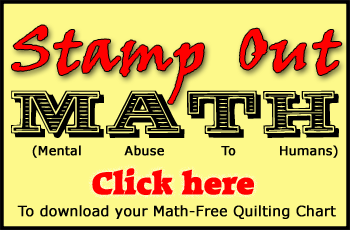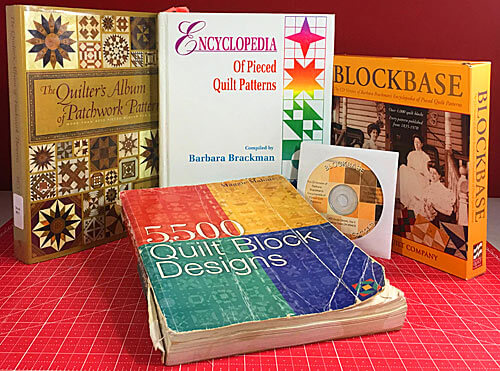- Home
- Beginner Quilt Blocks
- Flying Geese Quilt Block
Make a Flying Geese Quilt Block
Technique #2: Connector (or Folded) Corners
This post contains affiliate links, for which I receive compensation.
Learn how to make a Flying Geese quilt block and master the 'Connector' or 'Folded' corner technique.
With connector corners, instead of cutting triangles and sewing on exposed bias edges, squares are used instead.
Sew diagonally through the center of the patch, press and cut away the excess.

The result is a 'faux half square triangle' shape—with no bias edges to stretch out of whack.
For these Flying Geese you'll cut one rectangle and TWO squares to get the job done.
The math is super easy because the construction is based on the finished measurements of a rectangle. (But just in case, I've provided a downloadable cutting chart to keep handy for easy reference.)
Pros:
|
Cons:
|
The Technique
This method makes one traditional Flying Geese block twice as wide as it is tall.
The Connector Corner Formula
Geese Fabric: Cut a rectangle equal to the finished width plus 1/2" by the finished height plus 1/2"
Sky Fabric: Cut two squares equal to the finished height plus 1/2"
REMEMBER to download our free Cutting Chart below with dimensions for other common sizes. Just look for our 'Stamp Out Math' button below in the 'Download' section!
In this example, we're making a flying geese quilt block that finishes at 2" x 4" or 2-1/2" x 4-1/2" unfinished.
Helpful Tip
Use the grain line to your advantage.
Cut the long edge of the geese patch parallel to the selvedge.
There's less chance of distorting the block as you press.
Step 1
Calculate the size of the patches to cut.
From the geese fabric, cut one 2-1/2" x 4-1/2" rectangle...
2 + 1/2" = 2-1/2" tall
4" + 1/2" = 4-1/2" wide
From the sky material cut two 2-1/2" squares...
2 + 1/2" = 2-1/2"
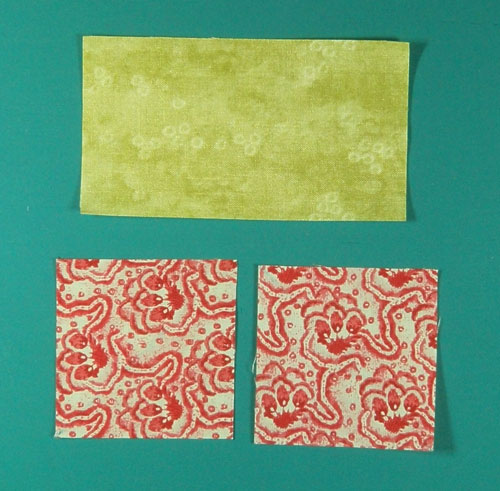
Step 2
Mark a diagonal line from corner to corner on the back of the two sky squares.
I've used a blue marker here so that you can see the line better. On my projects I like to use a mechanical pencil. The lead never dulls so the line stays nice and fine.
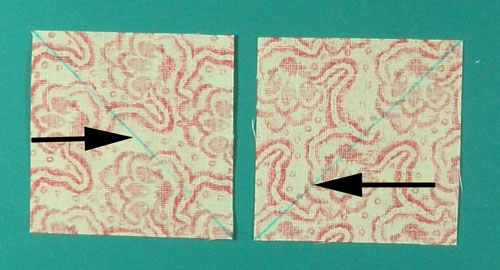 Draw the diagonal stitching lines on the sky fabric with a pencil
Draw the diagonal stitching lines on the sky fabric with a pencilStep 3
With right sides together (RST), align one square with one end of the rectangle. The drawn line should bisect the corner as shown below.
Stitch on the side of the drawn line that is opposite the goose. This compensates for the 'turn of the cloth' as it is folded over onto itself in the next few steps.
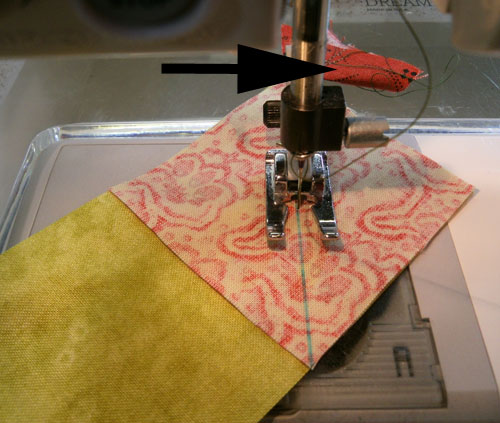 The arrow in the photo points out the scrap of fabric (aka 'spider') that I start sewing on first. This scrap helps prevent the sewing machine from 'eating' the point of the fabric as it feeds into the machine.
The arrow in the photo points out the scrap of fabric (aka 'spider') that I start sewing on first. This scrap helps prevent the sewing machine from 'eating' the point of the fabric as it feeds into the machine.Step 4
Trim the square on the outside edge of the block to a quarter inch (to reduce bulk).
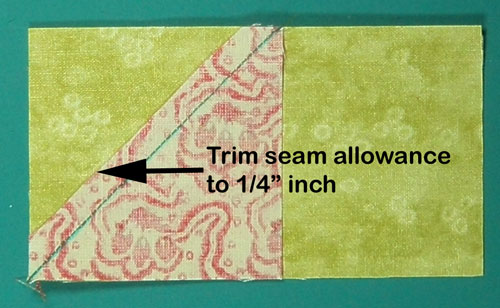 You can use either your rotary cutter or a scissor to do the trimming.
You can use either your rotary cutter or a scissor to do the trimming.Step 5
Press the unit flat to set the seam.
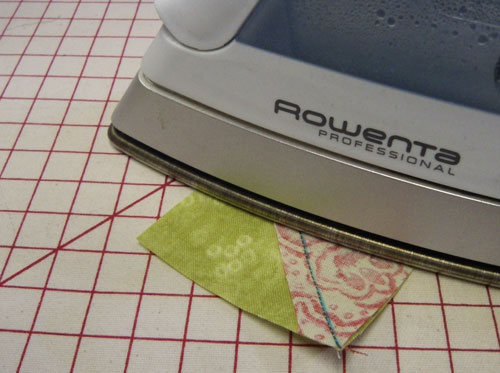
Then press the sky patch open towards the outside corner
Step 6
With RST, align the second sky patch with the opposite side of the geese rectangle. The drawn line bisects the corner on the same side of the block as in Step 3.
Sew on the side of the line opposite the goose. Again, this compensates for the 'turn of the cloth' as when you fold the sky fabric back upon itself.
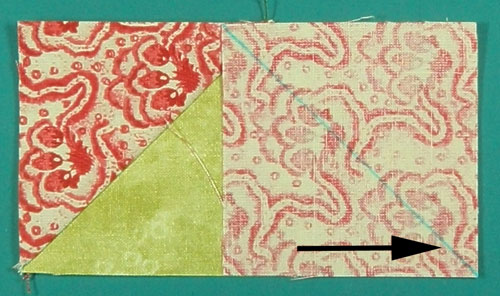
Step 7
Trim the patch to a quarter inch on the side of the stitching towards the outside corner.
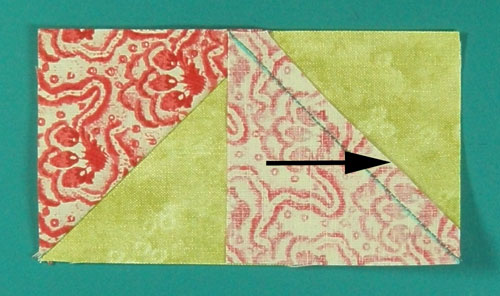 Again, use either a scissor or rotary cutter to trim
Again, use either a scissor or rotary cutter to trimStep 8
Press again—first flat to set the seam allowance.
Then press the unit open.
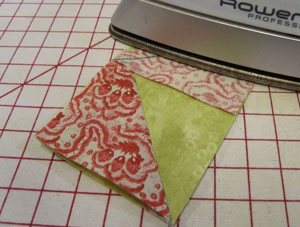
Your flying geese unit should look like this.
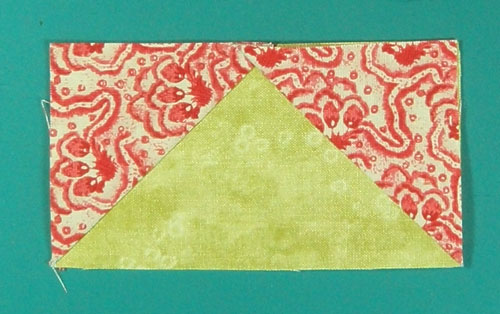
The beauty of this technique is the original geese rectangle is the correct size for the unit after it is stitched. That doesn't change during the process.
If you turn your patch to the back side, you shouldn't see any of the sky showing around the edges.
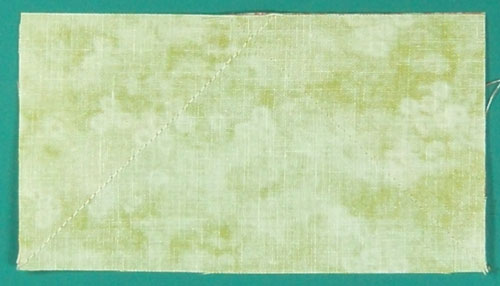 The back of the finished flying geese quilt block—nothing peeking out from the other side!
The back of the finished flying geese quilt block—nothing peeking out from the other side!About that excess fabric...
If you're a hand quilter...
...you won't care to repeatedly stitch through an extra layer of fabric. It's tiring.
After you trim your seam allowance and pressed the patch open in Steps 5&6 above, if the patch perfectly meets the edges of the geese rectangle, you CAN CHOOSE to trim BOTH fabrics to a quarter inch seam allowance.
Then after you've pressed the second sky patch and confirm that it, too, meets the edges, you can trim both to a quarter inch.
No more extra layer!
If you're machine quilting or having your quilt quilted by a longarmer, the extra bulk doesn't present much of a problem.
But if you love scrap quilting, you might want to...
Make bonus half square triangles
Instead of just trimming and discarding the excess fabric, you have another choice.
If your Flying Geese quilt block is large enough, sew a scant half inch away from the original sewing line, towards the sky part of the unit. (Scant half inch because you need enough for two seam allowances.)
With a scissor or rotary cutter, cut midway between the stitching lines to create a bonus half square triangle. Our 2"x4" finished Flying Geese quilt block provides two 1" finished HST units for very little extra work. The cutting chart that you can download indicates the largest bonus triangle you can get from a specific sized Flying Geese quilt block.
Store this HST bonanza in a separate box and trim as needed for upcoming projects!
Download and Print Cutting Chart
The formula for this Flying Geese quilt block is straight forward. But sometimes it's nice to have confirmation of the calculations that you've made.
To download and print our cutting chart for a variety of sizes, start by clicking the 'Stamp Out Math' button to the right. This brings up the PDF version of the page.
You'll need to have Adobe installed on your computer. If you don't have it, click here for the most current version of Adobe and install it on your computer. (This link opens in a new window.)
Click on the printer icon on your computer to print. Then just keep a copy by your sewing machine.
Easy Peasy!
What about a different quilt block?
For a list of all the 220+ quilt block patterns on this site, start here.
If you know the name of the block, shorten your search by using these links:
Click here if you're looking for blocks with at least some paper piecing.
Click here if you're looking for the basic building blocks of quilting, i.e., Flying Geese, half square triangles, quarter square triangles, etc., along with several techniques to make each.
And finally, use these links to find blocks in these finished sizes:
For even more blocks to make...
For you, are quilt block designs like potato chips...
...you can't have just one?!!
Check the amazing resources I rely on for all the quilt block designs you see on this website.
To see if they're worthy of a spot in YOUR quilting library, CLICK HERE.
